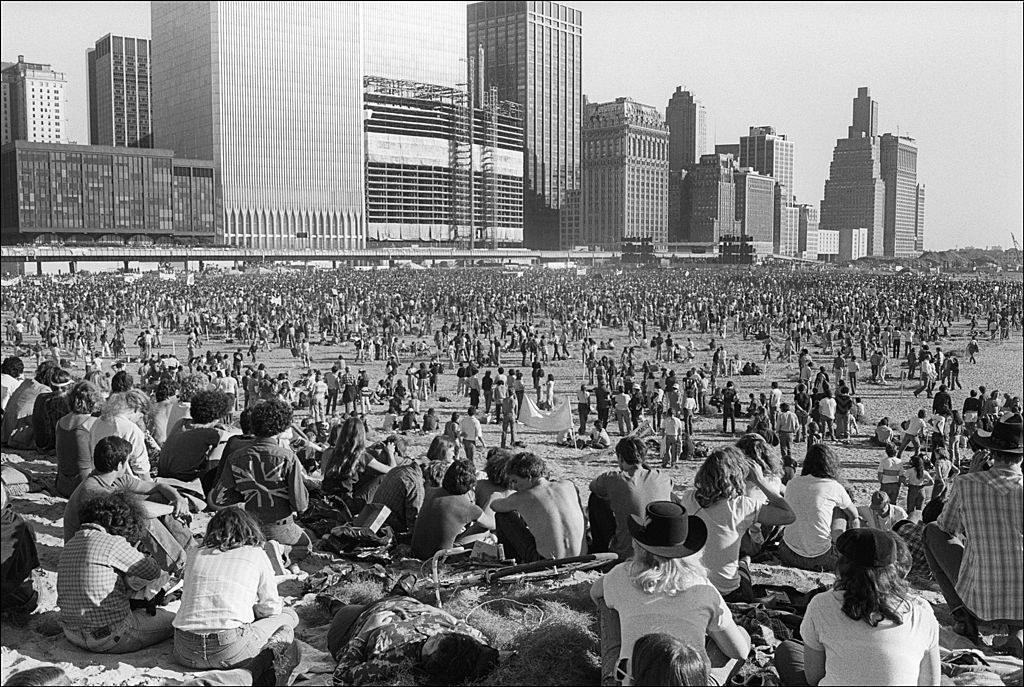
Not long ago, a jaw-dropping image flashed across my phone screen – a breathtaking shot of the Twin Towers in Manhattan, with a stunning beach right in the foreground.
People were lounging in the sand, as if they were on a tropical paradise. But could this really be true?
New York City’s forgotten beach oasis
Today, if you stroll along the waters near Battery Park, in the vicinity of where the Twin Towers once stood, it’s nearly impossible to imagine that a beach once stretched along the shore.
Now, the area is lined with sleek buildings and bustling streets, with the sound of the city filling the air. The water laps quietly against a modern promenade, offering views of the Statue of Liberty in the distance.

But the truth is, people once sunbathed here, basking in the warmth of the sun and the shadows of the World Trade Center. A forgotten beach oasis with its very own sandy shoreline, where the bustle of the city seemed worlds away, and the waters of Manhattan’s harbor embraced those seeking a rare slice of tranquility.
But, this sandy haven wasn’t part of any grand plan – it was an accidental oasis born from the construction delays of the World Trade Center in the mid-1970s.
Wasn’t meant for public use
As the massive foundation for the Twin Towers took shape, workers excavated earth from the nearby basin, creating a temporary beach along the waterfront.
Though it wasn’t meant for public use, Manhattanites quickly claimed it as their own, turning it into an unexpected retreat. Sunbathers lounged in the warm glow of the sun, volleyball games popped up in the sand, and readers found their peaceful spot by the water, all under the towering shadow of the World Trade Center.
What was once a construction site became a hidden gem and the stretch of sand became known as Battery Park Beach.
Incredibly, there are still people who remember what it was like to bathe on that beach — one of them being Suellen Epstein. Growing up in the nearby Tribeca neighborhood, she’s the one in the picture below, soaking up the summer sun in 1977.
In an interview with Tribeca Citizen, Suellen shared her memories of the beach, noting that the sand wasn’t exactly the soft, fine kind you’d find on a tropical shore. The sand was a bit rough, and of course, it was never kissed by the ocean waves.
But hey, it did the trick.
“We didn’t have resources to go out to the Hamptons,” Suellen told Tribeca Citizen and continued: “We were out there on the beach any sunny Sunday – as long as it wasn’t wet. It was a great place to get through the whole Sunday times.”
In the photo above, Suellen and her boyfriend enjoyed a rare moment of solitude. On the day the Times shot was taken, the beach was completely theirs.
”You felt like you weren’t in the city – like it was the Manhattan countryside,” Suellen recalled.
Hosting the largest anti-nuclear rally in history
The ”acres and acres of landfill” that eventually became the beach didn’t just serve as a peaceful retreat — it also became a powerful stage for social change. One iconic black-and-white photo, taken on September 23, 1979, captures a sandy no-man’s-land transformed into the heart of a massive anti-nuclear rally.
Hundreds of people sat in the sand, soaking in the sunny skies, free music, and a wave of controversy that drew 200,000 to the tip of Manhattan for what would become the largest anti-nuclear, pro-solar rally in history.

It wasn’t just the crowd that made the day unforgettable; the beach was packed with celebrities lending their voices to the cause. Folks like Pete Seeger and Jackson Browne performed, while Jane Fonda delivered a passionate speech.
The rally marked a rebirth of the national protest movement, which had largely faded after the end of the Vietnam War in 1975.
Now, the cause was nuclear power, and the catalyst for this renewed energy was the nuclear accident in Harrisburg earlier that year.
Striking installations
The Battery Park Beach, or Tribeca Beach, also served as a dynamic creative stage, alive with performances and artistic energy. Lots of small dance companies were thriving, and artists could actually afford to live and create in the city. Around that time, the public arts organization Creative Time received a grant to bring art to the beach, including a striking installation by local environmental artist Mary Miss.
In 1980, the beach became the stage for Art on the Beach, offering a unique opportunity for young sculptor Nancy Rubins to make her mark on this special location. At 27 years old, she was in awe of the massive scale of the site and the engineering behind it. She contributed a piece fashioned from discarded items like lampshades, hoses, and small appliances, which she sourced in bulk from various Goodwills.
Her creation ultimately became a 45-foot-tall tornado of junk.
“It was very humbling to work at that site. I was young, and it was so huge,” she told The New York Times.
A gigantic wheat field
Another striking installation on the site was Wheatfield – A Confrontation by artist Agnes Denes. Her work, a provocative commentary on the modern towers, consisted of two acres of wheat planted just blocks from Wall Street and the World Trade Center, facing the Statue of Liberty.
Denes and her team spent a month planting the wheat, with her working 16 hours a day to make it all come together. The piece was meant to introduce the financial power center of the country to the urgency of environmental concerns.
“Planting and harvesting a field of wheat on land worth $4.5 billion created a powerful paradox. Wheatfield was a symbol, a universal concept; it represented food, energy, commerce, world trade, and economics. It referred to mismanagement, waste, world hunger, and ecological concerns,” Denes describes the project on her website.
Looking at the photos of this project, it’s almost as awe-inspiring as the beach itself, don’t you think?
The truth behind the Manhattan beach photo
The creative spirit that brought David Vanden-Eynden and Chris Galori to the beach is also what drew me to this story in the first place. They’re the ones featured in the image below, taken by Fred Conrad, a former photographer for The New York Times. The photo was captured in 1977.
David, an environmental graphic designer, recalled the scene in an interview with The New York Times in 2019: “There was nothing there yet, and there were spectacular views of the towers and across the river.” He also revealed that some areas of the landfill were fenced off from the public, though not all of it was restricted.
The creative spirit that brought David Vanden-Eynden and Chris Galori to the beach is what drew me to this story in the first place — they’re the ones featured in the image below, taken by Fred Conrad, a former photographer for The New York Times.
The photo was captured in 1977.
David, an environmental graphic designer, recalled the scene in an interview with The New York Times in 2019:
“There was nothing there yet, and there were spectacular views of the towers and across the river.” He also revealed that while some areas of the landfill were fenced off from the public, not all of it was restricted.
The eerie truth behind the pictures
So, what happened to this almost unbelievable place?
According to The New York Times, things began to change in 1983 when nearly 3,000 people arrived in Battery Park City (today it has more of the vibe of a suburban office park than that of a true city neighborhood).
By 2000, nearly all of the former landfill had been developed.
But then, in 2001, something occurred that casts these images in an entirely different light. It’s hard not to think about what happened to the Twin Towers on that fateful September day, especially when looking at those sunbathers lounging so blissfully in the photos.
Today, we know what they couldn’t have: the tragic fate of the World Trade Center, a fate that would forever change the landscape of New York City.
There’s a certain elegiac and unsettling quality to these photos now. One person, reflecting on the images, noted, “My God! This picture contains it all: life, death, youth, age, stillness, anticipation.”
It’s hard not to feel the weight of that sentiment. These sunbathers, so carefree in their moment, couldn’t have imagined the horror that would unfold years later.
“So much could be said,” another continued. “But I’ll just look, and cry.”
And as we look at these now-iconic images, we’re reminded of the eerie truth: time marches on, and with it, everything changes — often in ways we never see coming.
Did you enjoy this story? Feel free to share it with your friends, preferably by hitting the share button on Facebook.
READ MORE
- Chilling story behind the famous 9/11 photo of a doomed fire truck heading toward the Twin Towers
- The heroic story of Christopher Amoroso on 9/11




